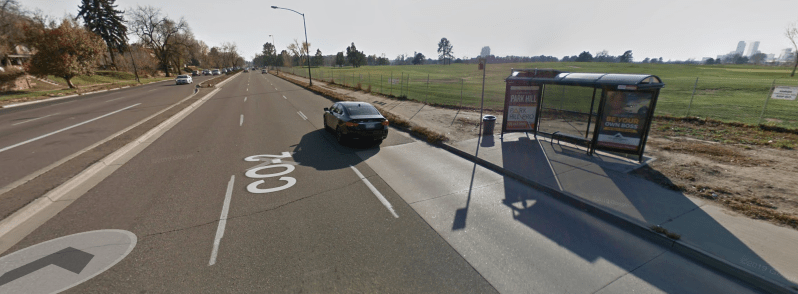Commentary: New Sidewalk on Colorado Blvd. Is An Insult That Remains Unsafe for Pedestrians

Jonathon Stalls, a walking advocate, created this video and essay about the the new sidewalk on Colorado Blvd., which replaced a sloping dirt path but remains a poorly designed, “violent, loud, and unsafe” place for pedestrians.
Pedestrian Dignity: Crumbs on Denver’s Colorado Blvd
It’s 6:45 am in the morning. Throughout the week, I’m often rushing out the door to walk anywhere from 10-30 minutes to catch the bus. Most of the time I have to plan to (A) catch a bus that runs before the one that would get me there on time in case it doesn’t show, (B) get to the stop 5-10 minutes early in case the bus is early, and (C) use the restroom and eat because there are next to zero public restrooms in the city of Denver and limited street food options. Most of the time I’m waiting well past the pick-up time because it’s anywhere from 5-30 minutes late. Walking and riding transit anywhere close to full-time is no joke in a time and in a place where every single street, neighborhood and city budget centers, idolizes, protects, and defends the untouchable automobile.
I live in Denver’s North Park Hill neighborhood. I often take the Regional Transportation District’s Route 40 which runs every 20-30 minutes along Colorado Boulevard. I, and many others, gather at the bus stops near the 26th and Colorado intersection. Cars fly by, often far surpassing the speed limit of 40 mph. If you have never walked Colorado Boulevard, you might not know that it is one of the most violent and uncared for state highways in the Denver Metro region. Imagine rain, snow, ice, nighttime, having your kids or groceries with you, experiencing balance challenges, using a wheelchair or stroller, working through an injury and so much more.

Before
The walking environment on the east side of the City Park Golf course and the west side of Colorado Boulevard between 23rd and 26th has always been difficult for pedestrians (see the photo above). In the past it was a dirt slope with mud and gravel. Sliding footprints of all shapes and sizes carried the story of struggling pedestrians for years. Pedestrians are people. They are a mix of breathing human beings who rely on the bus, live without a car, work hard to make ends meet, choose to not have a car to save money or reduce environmental impact, or perhaps, protect time to improve their family’s physical and mental health.

After
As someone who primarily walks for transportation, staying healthy, and feeling connected to the world outside of walls, I found the new recently poured sidewalk (above) to be insulting. To me, it’s a clear product of outdated policies, silos in decision-making, car-centric decision makers, and a public body that is further and further removed from awareness of or connection to the pedestrian experience. The status quo, in 2019, still seems to be treating pedestrian related planning and budgeting like crumbs. I can hear the conversations in some of these rooms. “If we get ‘them’ (as if pedestrians are somehow only a category and not actual people) a sidewalk, they will be happy or they will stop complaining.” While the new and thankfully, wide sidewalk is without a doubt an improvement to sliding mud slopes, it’s important to define a detached sidewalk and an attached sidewalk:
Attached sidewalk: a sidewalk that has no buffer zone and is paved all the way to the curb. Attached sidewalks can be violent, loud, and unsafe as pedestrians move more directly next to or against car traffic. Cars blast by, often spraying water, exhaust, and noise pollution into the very bodies of all those who must (or choose to) move by foot or on wheelchair.
Detached sidewalk: a sidewalk that has a buffer zone (grass, rocks, trees, or other landscaping) which helps pedestrians feel more protected and cared for from automobile traffic. The buffer zone acknowledges the unique and understood experience of the pedestrian. The dignity of moving by foot or on wheelchair is prioritized and budgeted for when new construction (especially around practical destinations) is implemented.
We simply need more leaders, developers, engineers, planners and residents to (A) stand firmly against an ongoing car-first ideology that continues to absorb so much of our environmental, social, and communal fabric in the United States of America and (B) boldly move towards a more human-centered relationship to transportation. Our kids, senior citizens, people with different abilities depend and need us to stand in this tension.
To many, using this example might feel like a waste of time. To those who depend on and walk as their first form of transportation, calling out the nuances around basic and uninspiring improvements like this means everything as we boldly push to truly envision streets that are designed for people.
I took a small 4-minute video while walking on this new sidewalk. I hope it inspires and invites you to acknowledge the need towards a future where our humanity and our right to walk becomes a bold and serious priority.
Jonathon Stalls walked across the United States in 2010, founded Walk2Connect in 2012 and now runs a creative project called Intrinsic Paths, which is centered on walking culture, engaged contemplation and pedestrian dignity.
Streetsblog Denver informs the movement for sustainable transportation and a livable city. Give $5 per month.


